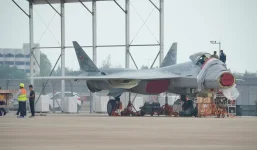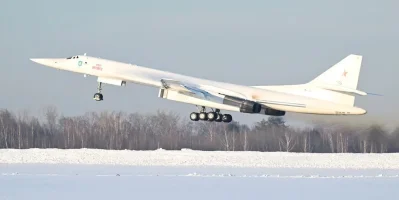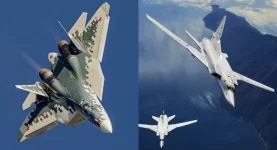- Views: 5K
- Replies: 51
In a potentially pivotal move for India's futuristic fighter jet program, Russia has proposed a joint effort to develop an advanced flat engine nozzle for the Advanced Medium Combat Aircraft (AMCA). This offer, however, is conditional upon India selecting Russia's new Izdeliye 177S engine to power the aircraft.
The proposal, stemming from talks initiated during the Aero India 2025 exposition and continuing through subsequent negotiations, highlights Russia's keen interest in deepening its longstanding defence relationship with India and equipping the AMCA with sophisticated stealth technology.
The Izdeliye 177S, described as a fifth-generation engine incorporating technology from the AL-51 (Izdeliye 30) developed for Russia's Su-57 fighter, presents India with a powerful option for its indigenous stealth aircraft.
India's AMCA project, a collaborative effort between the Defence Research and Development Organisation (DRDO) and Hindustan Aeronautics Limited (HAL), aims to produce a fifth-generation fighter featuring stealth characteristics, the ability to cruise faster than sound without afterburners (supercruise), and integrated advanced sensor systems for the Indian Air Force (IAF).
Central to achieving these ambitious goals is the choice of engine, which needs to deliver significant thrust while maintaining stealth and fuel efficiency.
The initial version, AMCA Mark 1, is planned to use the American General Electric F414 engine (producing 98 kN thrust). However, for the more advanced AMCA Mark 2, the IAF requires a more powerful engine, ideally generating 110-130 kN of thrust, potentially co-developed or produced domestically, to enable superior performance and supercruise capabilities. Russia's Izdeliye 177S engine, reportedly capable of 142 kN thrust with afterburner and designed with stealth features, significantly surpasses these requirements.
The Izdeliye 177S engine is being developed by Russia's United Engine Corporation (UEC), part of the Rostec state corporation. It incorporates next-generation technologies, some adapted from the AL-51 (Izdeliye 30) engine currently being integrated into Russia's Su-57 "Felon" fighter. The AL-51 represents a major advancement in Russian engine technology, offering better fuel economy, increased thrust relative to its weight, and design features that reduce its visibility to radar and infrared sensors.
Building on this, the 177S reportedly offers a much longer operational lifespan of up to 6,000 hours—a threefold increase compared to the AL-31FP engines used in India's current Su-30 MKI fighters—and includes stealth-treated thrust vector control (TVC) nozzles.
Significantly, the new Russian proposal for the AMCA involves replacing the standard circular nozzle with a flat, two-dimensional (2D) design, similar to that used on the American F-22 Raptor, specifically to enhance the AMCA's stealth properties.
Flat or 2D engine nozzles are considered a key feature of modern stealth aircraft design. They help reduce an aircraft's detectability by scattering radar waves differently than round nozzles and by shaping and cooling the engine exhaust plume more effectively, thereby reducing its infrared signature.
Russia's offer to co-develop this specific nozzle technology with India aligns with 'Make in India' policy. Such a partnership could see Indian engineers from HAL and DRDO collaborating directly with UEC specialists to adapt the nozzle for the AMCA airframe, possibly incorporating Indian materials and control systems. This collaboration could also facilitate valuable technology transfer, significantly boosting India's indigenous capabilities in aerospace and engine technology.
Despite the potential advantages, the Russian proposal includes notable risks. The Izdeliye 177S engine has not yet been extensively tested in flight conditions, with reports suggesting Rostec is awaiting confirmed orders before proceeding with comprehensive trials. This approach, combined with the known development delays experienced by the related AL-51 engine and the impact of ongoing international sanctions on Russia's defence industry, raises concerns about timely delivery and performance validation.
Furthermore, integrating a significantly heavier and more powerful engine (142 kN) like the 177S, along with a new flat nozzle, into the AMCA airframe – originally designed around the lighter GE F414 – would likely require substantial modifications. These changes could lead to increased aircraft weight, development costs, and potential delays to the AMCA program, which currently aims for induction between 2032 and 2035.
Relying heavily on Russian technology also presents strategic considerations for India, which has been seeking to diversify its defence acquisitions.
So, India faces a complex decision. Adopting the flat nozzle technology could significantly improve the AMCA's stealth capabilities, providing a crucial advantage against advanced aircraft operated by regional neighbours, such as China's J-20 and developmental J-36 fighters.
Joint development could also provide India's Gas Turbine Research Establishment (GTRE) with invaluable experience, aiding its long-term objective of achieving self-sufficiency in aero-engine technology.
However, India must carefully evaluate this offer against other possibilities. France's Safran has previously proposed collaborating on a 110 kN engine based on the Rafale's M88 engine core, and the United States might potentially offer advanced engine technology as part of broader strategic alignments.
Russia's proposal offers the allure of readily available fifth-generation engine power and co-production opportunities, but its viability depends crucially on factors like technological maturity, reliable timelines, mutual trust, and seamless technical integration.



